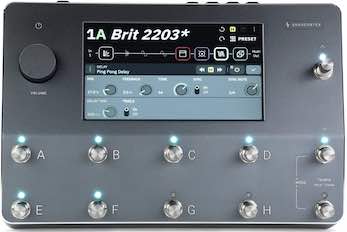The Song Sonic
An Interactive and Customizable Guitar Interface
Research
Modern Guitar Interfaces (Inspirations) |
|

|
Currently on the market, there exists a number of gutiar interfaces which allows the guitarist to plug their guitar into their computer, amplifier or other output device, as an input. The most simple and barebones interfaces include a way for the guitar to input, some controls for volume, an output via an audio plug, and a usb connection. Musicians will use these interfaces to play and record music from a variety of desired output devices. The advantage an audio interface has, is that it can work with any output device, allowing the musician to use their instrument with the device of their choosing. For me, my device of choice is my MacBook so I can use it for recording. While my intention is to use it for my guitar, these interfaces can be used with any electronic instruments such as MIDI keyboards, microphones, electronic drums, etc... |

|
Professional audio equipment like this exists as well. For example, the Neural DSP Quad Cortex Quad-Core Digital Effects Modeler comes with an enormous assortment of effects which can be applied to your instrument. It is described as having "Inside, more than 50 amps, 1,000 cabs, and 70 stomps serve as building blocks for crafting your favorite rigs, along with a built-in performance looper" which model or immitate real amplifiers, and cabinets. This can make it sound like any real equipment combos that are popular such as using a Marshall Head and Stack, without having to dedicate a large footprint to the amplifier system. The added effects cost a significant upcharge, but the convenience of accessibility, size and wide variety of options available make interfaces such as these very ideal in a recording or live environment. |
Pre-planning
Fab Academy Schedule Breakdown
Google Spreadsheet Detailing Project Plans:
Requirements and Constraints
In summary, clearly defining goals, requirements, and constraints can help keep a project on track and ensure that specific technical specifications are met. For example, if building a bridge, the requirement could be a weight capacity of 20 tons and the constraint could be a budget of $10 million. These parameters guide the project's development and help ensure its success.
In addition to helping keep a project on track and ensuring technical specifications are met, defining goals, requirements, and constraints can also help with organization and setting realistic expectations. By clearly outlining what needs to be achieved and the resources available, it becomes easier to create a plan that is manageable and achievable within the given constraints.
Here are my Requirements:
google doc linkHere are the Constraints:
google doc linkIn addition to requirements, "May Haves" are optional goals that may be added to a project if time and resources permit. These are not necessary for the project to be considered successful, but they can provide additional benefits if implemented. In the future, these "May Haves" may become actual requirements as the project evolves and expands.
Here are my "May Haves":
google doc link2D and 3D Modeling
Add here your modeling and design.
Electronics
add stuff